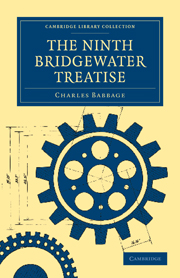Book contents
- Frontmatter
- Contents
- Preface
- Title in the Series
- CHAPTER I Nature of the Argument
- CHAPTER II Argument in favour of Design from the changing of Laws in Natural Events
- CHAPTER III Argument to show that the Doctrines in the preceding Chapter do not lead to Fatalism
- CHAPTER IV On the Account of the Creation, in the First Chapter of Genesis
- CHAPTER V Further View of the same Subject
- CHAPTER VI Of the Desire of Immortality
- CHAPTER VII On Time
- CHAPTER VIII Argument from Laws intermitting—on the Nature of Miracles
- CHAPTER IX On the permanent Impression of our Words and Actions on the Globe we inhabit
- CHAPTER X On Hume's Argument against Miracles
- CHAPTER XI À priori Argument in favour of the Occurrence of Miracles
- CHAPTER XII Thoughts on the Nature of Future Punishments
- CHAPTER XIII Reflections on Free Will
- CHAPTER XIV Thoughts on the Origin of Evil
- CONCLUSION
- APPENDIX
- CORRECTIONS
CHAPTER V - Further View of the same Subject
Published online by Cambridge University Press: 05 October 2010
- Frontmatter
- Contents
- Preface
- Title in the Series
- CHAPTER I Nature of the Argument
- CHAPTER II Argument in favour of Design from the changing of Laws in Natural Events
- CHAPTER III Argument to show that the Doctrines in the preceding Chapter do not lead to Fatalism
- CHAPTER IV On the Account of the Creation, in the First Chapter of Genesis
- CHAPTER V Further View of the same Subject
- CHAPTER VI Of the Desire of Immortality
- CHAPTER VII On Time
- CHAPTER VIII Argument from Laws intermitting—on the Nature of Miracles
- CHAPTER IX On the permanent Impression of our Words and Actions on the Globe we inhabit
- CHAPTER X On Hume's Argument against Miracles
- CHAPTER XI À priori Argument in favour of the Occurrence of Miracles
- CHAPTER XII Thoughts on the Nature of Future Punishments
- CHAPTER XIII Reflections on Free Will
- CHAPTER XIV Thoughts on the Origin of Evil
- CONCLUSION
- APPENDIX
- CORRECTIONS
Summary
Before entering on the main argument it may be remarked, that the plainest and most natural view of the language employed by the sacred historian of the earth is, that his expressions ought to be received by us in the sense in which they were understood by the people to whom he addressed himself. If, when speaking of the creation, instead of using the terms light and water, he had spoken of the former as a wave, and of the latter as the union of two invisible airs, he would assuredly have been perfectly unintelligible to his countrymen. At the distance of above three thousand years his writings would just have begun to be comprehended, and possibly three thousand years hence those views may be as inapplicable to the then existing state of human knowledge as they would have been when the first chapter of Genesis was written.
Those, however, who attempt to disprove the facts presented by observation, by placing them in opposition to revelation, have mistaken the very groundwork of the question. The revelation of Moses itself rests, and must necessarily rest, on testimony. Moses, the author of the oldest of the sacred books, lived about fifteen hundred years before the Christian era, or about three thousand three hundred years ago. The oldest manuscripts of the Pentateuch at present known, appear to have been written about 900 years ago.
- Type
- Chapter
- Information
- The Ninth Bridgewater Treatise , pp. 72 - 81Publisher: Cambridge University PressPrint publication year: 2009First published in: 1837



